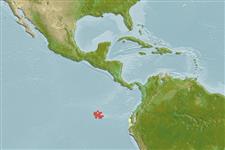Environment: milieu / climate zone / depth range / distribution range
Ecología
marino asociado a arrecife; rango de profundidad 0 - 5 m (Ref. 5227). Tropical
Eastern Pacific: Galapagos Islands.
Tamaño / Peso / Age
Maturity: Lm ? range ? - ? cm
Max length : 8.5 cm TL macho / no sexado; (Ref. 5227)
Lives in tide pools, shallow, rocky, boulder strewn areas and walls. Prefers deeper water habitats (Ref. 5227).
Life cycle and mating behavior
Maturities | Reproducción | Spawnings | Egg(s) | Fecundities | Larva
Allen, G.R. and D.R. Robertson, 1994. Fishes of the tropical eastern Pacific. University of Hawaii Press, Honolulu. 332 p. (Ref. 11482)
IUCN Red List Status (Ref. 130435)
Threat to humans
Harmless
Human uses
Herramientas
Special reports
Download XML
Fuentes de Internet
Estimates based on models
Preferred temperature (Ref.
123201): 23.5 - 24.9, mean 23.8 °C (based on 18 cells).
Phylogenetic diversity index (Ref.
82804): PD
50 = 0.5000 [Uniqueness, from 0.5 = low to 2.0 = high].
Bayesian length-weight: a=0.00912 (0.00399 - 0.02083), b=3.06 (2.87 - 3.25), in cm total length, based on LWR estimates for this (Sub)family-body shape (Ref.
93245).
Nivel trófico (Ref.
69278): 3.5 ±0.4 se; based on size and trophs of closest relatives
Fishing Vulnerability (Ref.
59153): Low vulnerability (10 of 100).
Nutrients (Ref.
124155): Calcium = 128 [69, 239] mg/100g; Iron = 0.807 [0.461, 1.373] mg/100g; Protein = 18.9 [17.7, 19.9] %; Omega3 = 0.138 [0.079, 0.239] g/100g; Selenium = 15.1 [7.2, 31.2] μg/100g; VitaminA = 200 [63, 650] μg/100g; Zinc = 2.18 [1.44, 3.14] mg/100g (wet weight);
